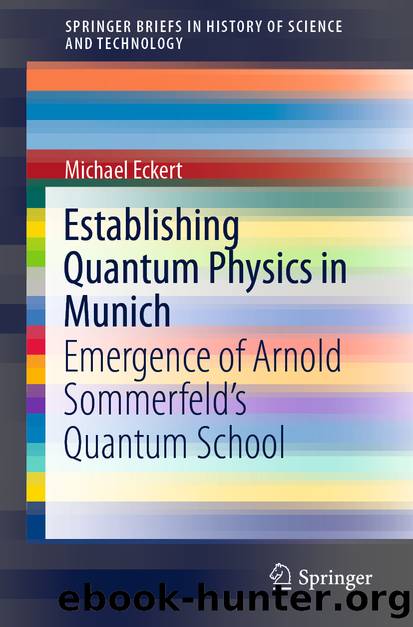Establishing Quantum Physics in Munich by Michael Eckert

Author:Michael Eckert
Language: eng
Format: epub
ISBN: 9783030620349
Publisher: Springer International Publishing
Although Epsteinâs recollection seems to dramatize his rivalry with Schwarzschild, it is by and large confirmed by the archival record. Both used methods from celestial mechanics. âI am very impressed that you cavort in Belgium and in quantum heaven at the same time,â Sommerfeld wrote in a response to a letter in which Schwarzschild, who was drafted for war service in Belgium, had reported how he approached the problem by using action-angle-variables. âAlthough I am not familiar with your notions from general celestial mechanics [...] I think that our views are not far apart from another.â25 Schwarzschild reformulated Sommerfeldâs quantization scheme by adapting the Hamilton-Jacobi formalism to quantum problems with the more general action integrals instead of Sommerfeldâs original phase integrals as the appropriate quantities for quantization. In a four-page letter dated March 21, 1916, he reported how he had solved the Stark effect problem.26 Sommerfeld responded three days later that Epstein had, at the same time, arrived at a âmore general formulaâ that also contained a line missing in Schwarzschildâs result.27 Epsteinâs and Schwarzschildâs preliminary communications were submitted for publication a week later (with one day difference). Schwarzschild died a few weeks later from a skin disease. Sommerfeld commemorated him in a paper titled âThe Quantum Theory of Spectral Lines and the Last Work of Karl Schwarzschildâ (Sommerfeld 1916b).
With Epsteinâs and Schwarzschildâs work, the somewhat haphazard schemes of quantizing used by Bohr, Sommerfeld, and more recently, Planck (Eckert 2008) assumed a more coherent form that could be used to solve quantum problems. First, the equations of motion of the mechanical problem needed to be translated into the language of Hamilton-Jacobi formalism. The first (and most difficult) part of this procedure was to find out in which coordinates the classical problem was separable, specifically, to find the canonical form of the equations of motion. The âquantumâ part of the problem was then fairly straightforward following Hamilton-Jacobi formalism. Sommerfeld first applied this procedure to the problem of the Zeeman effect. He had already indicated in his Annalen paper (Sommerfeld 1916a) that the plane orbit of an electron becomes spatially deformed by an applied magnetic field. The Hamilton-Jacobi approach to this problem led to phase integrals that were subject to complex integrationâSommerfeldâs specialty since his period in Göttingen as a mathematician. In September 1916, Sommerfeld submitted a paper to the Physikalische Zeitschrift (chosen for rapid publication to ensure high priority) where he presented this procedure for the Zeeman and the Stark effects, comparing both non-relativistic and relativistic motion. He also used the opportunity to simplify Epsteinâs and Schwarzschildâs treatments of the Stark effect. With its focus on Hamilton-Jacobi formalism and complex integration, the paper presented concrete examples so that it could be taken as a role model for further applications (Sommerfeld 1916c).
Debye, who had in the meantime moved to Göttingen as director of the Physical Institute, published practically the same results on the Zeeman effect in the same issue of the Physikalische Zeitschrift. They were obtained by basically the same procedure and further emphasized this method of quantization (Debye 1916).
Download
This site does not store any files on its server. We only index and link to content provided by other sites. Please contact the content providers to delete copyright contents if any and email us, we'll remove relevant links or contents immediately.
The Complete Stick Figure Physics Tutorials by Allen Sarah(7262)
Secrets of Antigravity Propulsion: Tesla, UFOs, and Classified Aerospace Technology by Ph.D. Paul A. Laviolette(5236)
Thing Explainer by Randall Munroe(3845)
The River of Consciousness by Oliver Sacks(3493)
The Order of Time by Carlo Rovelli(3093)
How To by Randall Munroe(2966)
A Brief History of Time by Stephen Hawking(2908)
I Live in the Future & Here's How It Works by Nick Bilton(2898)
The Great Unknown by Marcus du Sautoy(2611)
What If?: Serious Scientific Answers to Absurd Hypothetical Questions by Randall Munroe(2585)
Midnight in Chernobyl by Adam Higginbotham(2429)
Blockchain: Ultimate Step By Step Guide To Understanding Blockchain Technology, Bitcoin Creation, and the future of Money (Novice to Expert) by Keizer Söze(2406)
Networks: An Introduction by Newman Mark(2301)
The Meaning of it All by Richard Feynman(2266)
Easy Electronics by Charles Platt(2249)
The Tao of Physics by Fritjof Capra(2201)
Midnight in Chernobyl: The Untold Story of the World's Greatest Nuclear Disaster by Adam Higginbotham(2125)
When by Daniel H Pink(2056)
Introducing Relativity by Bruce Bassett(2045)
